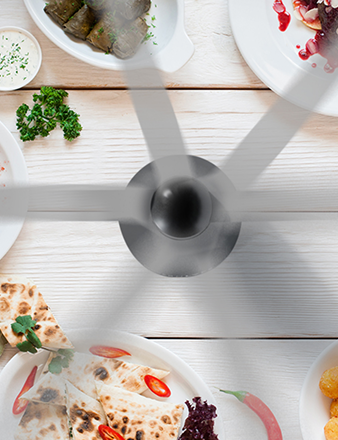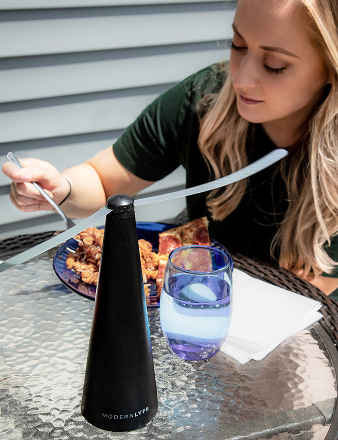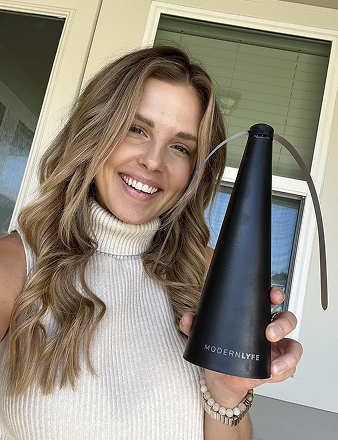Yes, a simple fan is one of the most effective tools for keeping mosquitoes away. The constant breeze makes it nearly impossible for these weak insects to fly and land on you. It also scatters the signals—your breath and body odor—that attract them in the first place.
How Fans Repel Mosquitoes
It sounds too simple to work, but the science behind using a fan for mosquito control is solid. This low-tech, chemical-free solution disrupts the two primary ways mosquitoes hunt: their sense of smell and their ability to fly.
First, the physical force of the wind creates an environment mosquitoes can't handle. These pests are notoriously poor fliers. A steady breeze is enough to throw them off course, preventing them from ever getting close enough to bite.
Scent Disruption is Key
The real genius of this method is how a fan messes with their ability to find you. Mosquitoes are masters at tracking the carbon dioxide (CO2) you exhale and the unique scents on your skin.
A fan creates a turbulent pocket of air that dilutes and scatters these chemical signals. By breaking up your scent trail, you become invisible to mosquitoes in the area. They can't lock onto you, turning your patio into a no-fly zone without any chemical sprays.
This isn't just theory; research backs it up. Studies confirm that a basic electric fan can drastically reduce mosquito landings. One notable study found that a fan reduced mosquito landings by up to 45% simply by making it harder for them to find their targets.
A fan doesn't just blow mosquitoes away—it makes you undetectable. By scattering your scent signature (CO2 and body odors), you disappear from their radar.
The Added Perks of Airflow
Let’s not forget the other benefits. On a hot summer evening, a cooling breeze is a welcome relief, making your deck or porch a more pleasant place to be. This dual-purpose function makes a fan one of the most practical additions to any outdoor gathering.
If you’re building a multi-layered defense against summer pests, a fan is the perfect foundation. You can dive deeper into choosing the best outdoor fans to keep bugs away in our detailed guide. It's a simple tool that protects you and boosts the comfort of your outdoor space.
Comparing Mosquito Control Methods
When deciding how to protect your outdoor space, it helps to see how different methods stack up. Here’s a quick comparison of fans versus other common mosquito control options.
| Method | Effectiveness | Safety | Cost | Coverage Area |
|---|---|---|---|---|
| Fans | Moderate to High | Very High (no chemicals) | Low (one-time purchase) | Targeted Area (6-10 ft) |
| Sprays (DEET) | High | Moderate (skin irritation) | Low (per can) | Personal |
| Citronella Candles | Low to Moderate | Moderate (fire/smoke risk) | Low | Small (3-5 ft) |
| Bug Zappers | Low (kills beneficial insects) | Moderate (can be a fire hazard) | Moderate | Medium |
| Repellent Coils | Moderate | Low (smoke inhalation) | Low | Small (5-10 ft) |
While chemical repellents are effective, fans offer a safe and cost-effective alternative for creating a bite-free zone. They are ideal for people with sensitive skin or for use around children and pets where chemical exposure is a concern.
Choosing the Right Fan for Your Outdoor Space
To win the war against mosquitoes, not just any fan will do. To create a truly bite-free bubble, you need a fan with enough power to disrupt their flight and scatter your scent. Forget features like misters or ionizers; the only spec that matters is CFM, or Cubic Feet per Minute.
CFM measures how much air a fan can move. For outdoor use, a high CFM is non-negotiable. A weak indoor fan won’t stand up to a light breeze outside, making it useless. You need something that can generate a strong, steady stream of air right where you're sitting.
This chemical-free approach is gaining traction. A 2023 survey revealed that 38% of U.S. households now use fans for mosquito defense, and 62% of those users reported a significant drop in bites. Research shows that a fan pushing out at least 1,000 CFM can cut mosquito landings by up to 50% outdoors. You can explore more trends in the growing insect repellent market at Grandview Research.
Match the Fan to Your Needs
Once you're set on a powerful CFM, pick a fan style that works for your space. Different fans have different strengths, and the best choice depends on your setup.
-
High-Velocity Floor Fans: These are the heavy hitters of mosquito control. Often called drum or industrial fans, they move a serious amount of air, with CFMs of 2,000 or higher. They are perfect for large patios and decks. Because they sit low, they're great at aiming air across the lower half of your body, where mosquitoes often fly.
-
Pedestal (Standing) Fans: This is your versatile, all-around champion. Pedestal fans are adjustable in height and often oscillate, letting you aim the breeze exactly where you need it, from a dining table to a group of lounge chairs. Just get one with a solid, heavy base so it won't tip over.
-
Wall-Mounted Fans: If you need a permanent, set-it-and-forget-it solution, a wall-mounted fan is a smart choice. You'll save floor space and can place it strategically to create a constant cross-breeze over a specific area, like an outdoor bar.
-
Box Fans: They're cheap and work in a pinch for a small, sheltered spot like a balcony. But they generally lack the focused power and durability for larger, more open spaces.
The key takeaway is simple: Power over features. A no-frills fan with a high CFM will always outperform a feature-packed but weak fan for keeping mosquitoes away.
Choosing the right fan is about matching airflow to your environment. For a closer look at specific models, check out our comprehensive guide on selecting the perfect outdoor mosquito fan. We've put together detailed comparisons to help you keep your outdoor gatherings comfortable and bite-free.
Smart Fan Placement For Maximum Protection
A powerful fan is a great start, but where you place it is what turns it into a mosquito-free zone. Think of it as setting up a strategic perimeter. Your goal is to create targeted airflow that makes it physically impossible for these weak flyers to get near you.
The biggest mistake people make is aiming the fan too high. It feels good on a hot day, but it does little to stop bugs. Mosquitoes, especially ankle-biters like the Aedes aegypti, almost always fly low to the ground—typically below three feet. They stay out of the wind while tracking the carbon dioxide you exhale, which is heavier than air and sinks.
Your number one job is to disrupt that low-altitude flight path.
Aim Low and Create a Wind Wall
To get this right, you have to think like a mosquito. Since they’re buzzing around your ankles, your fan's airflow needs to be aimed squarely at the lower half of your body. This creates a powerful, invisible barrier right where they want to be.
For a small space, like two chairs on a balcony, a single floor fan is usually enough. Position it a few feet away and point it directly at your legs. The breeze should be strong enough to feel but not so intense that it's blowing things around.
A fan aimed at your face feels nice, but it won't stop mosquitoes from feasting on your ankles. Always prioritize a strong, low-level breeze that guards the lower half of your body.
This small adjustment—tilting the fan down—is a game-changer. It turns your fan from a simple comfort item into your best mosquito-repelling tool.
This guide breaks down the process for choosing the right fan: start with your space, then determine your power needs, and finally pick the best type for the job.
It's a simple flow: assess your space, ensure you have enough power (CFM), and then pick a fan model that fits.
Placement Blueprints for Common Scenarios
The perfect setup isn't one-size-fits-all. A quiet dinner needs a different approach than a big backyard party. Here are a few proven placement strategies for common outdoor gatherings.
The Dinner Party
The goal is to protect everyone at the table without creating a windstorm.
- For a rectangular table, use two pedestal fans, one at each end.
- Set them to medium speed and adjust the height so the airflow hits everyone from the waist down.
- If the fans oscillate, set them to a narrow range to keep the breeze focused on your guests.
The Casual Lounge Area
For a scattered seating arrangement like patio sofas and lounge chairs, you need broader coverage.
- You'll likely need two or three high-velocity floor fans.
- Place them on the perimeter of the seating area, all pointing inwards.
- This creates a powerful cross-breeze, forming a protective "wind wall" around the whole space that mosquitoes can't penetrate.
Here’s a quick reference table to help you visualize the best approach.
Outdoor Fan Placement Cheat Sheet
| Scenario | Number of Fans | Optimal Placement Strategy | Key Tip |
|---|---|---|---|
| Small Balcony (1-2 people) | 1 | Place a floor fan 3-5 feet away, aimed directly at your legs. | Keep it simple. A single, focused breeze is all you need. |
| Dining Table (4-8 people) | 2 | Use two pedestal fans at opposite ends of the table, creating a low "tunnel" of air. | Set to a medium speed. You want to deter bugs, not chill the food. |
| Large Patio Lounge | 2-3 | Position fans at the perimeter, pointing inwards to create a protective cross-breeze. | Overlap the airflow zones slightly to eliminate calm spots where mosquitoes can hide. |
| Outdoor Bar or Buffet Line | 1-2 | Aim fans along the length of the bar or table to keep bugs away from food and guests. | Focus on keeping the air moving constantly over the serving area. |
This table provides a solid starting point, but don't be afraid to experiment to find what works best for your layout.
A final, crucial point: be mindful of power cords. Always use outdoor-rated extension cords and tape them down or use cord covers. The last thing you want is a tripping hazard.
Creating a Protective Bubble with Multiple Fans
When protecting a large patio or hosting a party, one fan isn't enough. To truly reclaim your space from mosquitoes, you need to think bigger. Create a coordinated system with multiple fans to build an overlapping, impenetrable barrier of moving air.
This isn't just about more wind; it's about engineering a cross-breeze. By positioning two or more fans, you can build a network of airflow that blankets the entire social area. This strategy eliminates the calm pockets of air where mosquitoes hide, effectively turning your patio into a no-fly zone.
Designing Your Multi-Fan Layout
The goal is simple: arrange fans around the perimeter of your gathering space, pointing inward and slightly overlapping. Think of it as building an invisible fence made of wind. The slight overlap in airstreams is critical—it ensures there are no gaps for mosquitoes to slip through.
Here's a common setup for a rectangular patio with a dining table and a lounge area:
-
Fans 1 & 2 (Pedestal Fans): Place one at each end of the dining table. Aim them low to create an air "tunnel" that shields everyone's legs and keeps bugs off the food. A medium, oscillating setting usually works perfectly.
-
Fan 3 (High-Velocity Floor Fan): This is your workhorse. Position it near the lounge seating, aimed across the open area. It acts as the main wind wall, guarding the most exposed part of your patio.
With a setup like this, every guest is inside a protective pocket of airflow. The combined currents make it incredibly difficult for a mosquito to navigate, let alone land for a bite.
The best multi-fan setups create a coordinated cross-breeze. Overlapping the airflow from several fans leaves no calm air for mosquitoes to navigate, effectively sealing off your entire social space.
Managing Power and Noise Safely
Running multiple fans requires some planning, especially for power cords and noise levels. The goal is to keep everyone safe and comfortable, not just bug-free.
First, power. Always use outdoor-rated extension cords for any fan running outside. They’re built to handle moisture and sunlight. To prevent tripping, tape the cords down with gaffer tape or use cord covers. Never use an indoor extension cord outdoors—it’s a major safety hazard.
Noise is the other consideration. High-velocity fans are effective but can be loud. Place the fans as far from the main seating area as possible without losing effectiveness. Running three fans on a medium setting is often quieter and more effective than blasting two on high. This gives you a pleasant background hum instead of a roar, while your fan to keep mosquitoes away does its job.
Boosting Your Fan’s Power with Other Methods
A good fan is a great weapon against mosquitoes, but it's even better when layered with other smart tactics. Think of your fan as the centerpiece of a complete mosquito defense system. By combining methods, you create a multi-faceted barrier that makes your space inhospitable to these pests.
For example, a fan is brilliant at extending the reach of scent-based repellents. A citronella candle or essential oil diffuser has a small zone of influence on its own. But place a fan a few feet behind it, and you'll push those repellent scents across a much larger area, creating a more effective protective bubble.
Eliminate Mosquito Breeding Grounds
The single best thing you can do to fight mosquitoes is to get rid of their breeding grounds. It takes very little standing water—sometimes no more than a bottle cap—for a mosquito to lay hundreds of eggs. Before guests arrive, take five minutes to scout your yard.
- Tip over flowerpot saucers to drain rainwater.
- Check for clogged gutters where water is pooling.
- Cover or flip over buckets, wheelbarrows, and kids’ toys.
Here’s another way your fan can help: after it rains, aim it at damp spots on your deck or patio. The airflow will dry those surfaces much faster, eliminating potential egg-laying sites before mosquitoes can find them. It's a proactive move that cuts down the local mosquito population.
Combining a fan with source reduction (eliminating standing water) is the ultimate one-two punch. The fan protects you from existing mosquitoes, while getting rid of water stops new ones from hatching.
The Global Shift to Smarter Control
This combination of physical and environmental controls isn't just a backyard hack; it reflects a major global trend. As awareness of vector-borne diseases grows, the mosquito control market is booming. The Asia Pacific region, which held 35.06% of the global market share in 2024, has long embraced fans as a supplementary control method.
A 2022 study in Thailand found that households using fans saw a 30% reduction in mosquito bites compared to those relying only on chemical repellents.
When you pair your fan with other smart strategies, you're adopting a more sustainable and effective approach to pest control. For more ideas on specialized setups, you might be interested in our guide on the OFF! insect repellent fan, which explores another unique tool for your arsenal.
Still Have Questions About Mosquito Repellent Fans?
Using a fan to keep mosquitoes away is straightforward, but a few questions always come up. Let's clear up some common concerns to ensure your setup is perfect.
Does the fan need to be on high speed?
Not necessarily. You don't need a wind tunnel—just a consistent, noticeable breeze where you're sitting.
For a dining table, a medium setting is often the sweet spot. It's strong enough to disrupt a mosquito's flight but gentle enough that it won't blow your napkins away. For a larger lounge area, you might need to use a higher speed to move air effectively across the whole space.
What's the best type of fan to use?
The type of fan matters less than its performance. While a high-velocity floor fan moves a lot of air, a well-placed pedestal fan or a couple of oscillating wall-mounted fans can work just as well.
The most important factor is its ability to generate enough airflow (measured in CFM, or cubic feet per minute) and your ability to aim that airflow where it counts: low to the ground where mosquitoes fly.
Will fans work on other bugs, too?
Yes, they can. The same breeze that stops mosquitoes is just as disruptive to other weak-flying pests like gnats and houseflies. They can't fight a steady wind, making a fan a great multi-purpose tool for keeping your immediate area pest-free.
However, it's not a magic bullet. Stronger insects like bees, wasps, and larger beetles can power through the wind without much trouble.
A fan's strength is disrupting weak fliers. It's fantastic for mosquitoes and gnats, but it won't create a force field against every bug out there.
Is it okay to leave my fan outside?
This is an important safety point. Never leave a standard indoor fan outside for an extended period. These fans aren't designed to handle moisture from rain or even morning dew. Water can cause electrical shorts, create a fire hazard, and lead to rust.
If you want a permanent solution for the season, you need to buy a fan specifically rated for outdoor use. These are built with weather-resistant motors and durable components that can stand up to the elements. Otherwise, just bring your indoor fan back inside when you're done.
For a stylish and effective way to protect your dining areas from flies and other pests, MODERN LYFE offers innovative fan solutions that blend seamlessly into any setting. Discover the perfect fan for your home or business at https://modernlyfe.com.






